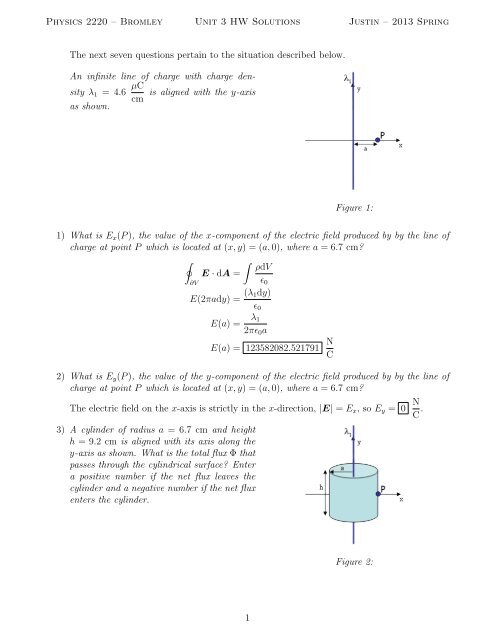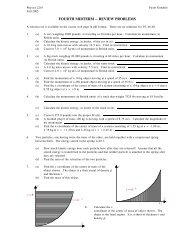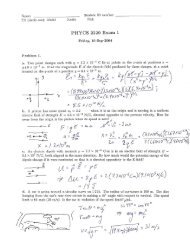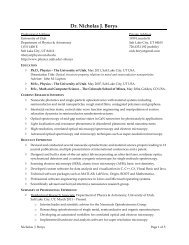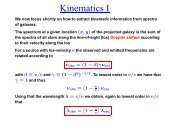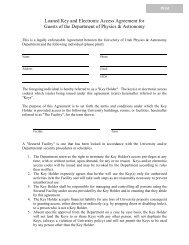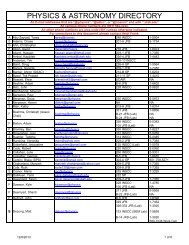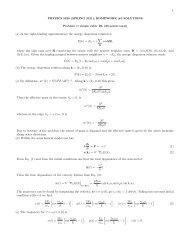Homework 2
Homework 2
Homework 2
You also want an ePaper? Increase the reach of your titles
YUMPU automatically turns print PDFs into web optimized ePapers that Google loves.
Physics 2220 – Bromley Unit 3 HW Solutions Justin – 2013 Spring<br />
The next seven questions pertain to the situation described below.<br />
An infinite line of charge with charge density<br />
λ 1 = 4.6 µC is aligned with the y-axis<br />
cm<br />
as shown.<br />
Figure 1:<br />
1) What is E x (P ), the value of the x-component of the electric field produced by by the line of<br />
charge at point P which is located at (x, y) = (a, 0), where a = 6.7 cm?<br />
∮<br />
∫ ρdV<br />
E · dA =<br />
∂V<br />
ɛ 0<br />
E(2πady) = (λ 1dy)<br />
ɛ 0<br />
E(a) = λ 1<br />
2πɛ 0 a<br />
E(a) = 123582082.521791 N C<br />
2) What is E y (P ), the value of the y-component of the electric field produced by by the line of<br />
charge at point P which is located at (x, y) = (a, 0), where a = 6.7 cm?<br />
The electric field on the x-axis is strictly in the x-direction, |E| = E x , so E y = 0 N C .<br />
3) A cylinder of radius a = 6.7 cm and height<br />
h = 9.2 cm is aligned with its axis along the<br />
y-axis as shown. What is the total flux Φ that<br />
passes through the cylindrical surface? Enter<br />
a positive number if the net flux leaves the<br />
cylinder and a negative number if the net flux<br />
enters the cylinder.<br />
Figure 2:<br />
1
Physics 2220 – Bromley Unit 3 HW Solutions Justin – 2013 Spring<br />
∫ ∫ h<br />
ρdV<br />
2 λ 1 dy<br />
Φ E = = = λ 1h<br />
ɛ 0 − h ɛ<br />
2 0 ɛ 0<br />
4) Another infinite line of charge with charge<br />
density λ 2 = −13.8 µC parallel to the y-axis<br />
cm<br />
is now added at x = 3.35 cm as shown. What<br />
is the new value for E x (P ), the x-component<br />
of the electric field at point P ?<br />
= 4786274.92451412 N · m2<br />
C<br />
Figure 3:<br />
E x (P ) = E 1x (P ) + E 2x (P ) = λ 1<br />
2πɛ 0 a + λ 2<br />
= −617910412.608955 N C<br />
2πɛ 0<br />
(<br />
a −<br />
a<br />
2<br />
) = 1 ( )<br />
λ1<br />
πɛ 0 a 2 + λ 2<br />
5) What is the total flux Φ that now passes through the cylindrical surface? Enter a positive<br />
number if the net flux leaves the cylinder and a negative number if the net flux enters the<br />
cylinder.<br />
Φ =<br />
∫ ρdV<br />
ɛ 0<br />
= 1 ɛ 0<br />
( ∫ L<br />
2<br />
− L 2<br />
λ 1 dy +<br />
∫ L<br />
2<br />
− L 2<br />
λ 2 dy<br />
6) The initial infinite line of charge is now<br />
moved so that it is parallel to the y-axis at<br />
x = −3.35 cm. What is the new value for<br />
E x (P ), the x-component of the electric field<br />
at point P ?<br />
)<br />
= h ɛ 0<br />
(λ 1 + λ 2 ) = −9572549.84902824 N · m2<br />
C<br />
Figure 4:<br />
2
Physics 2220 – Bromley Unit 3 HW Solutions Justin – 2013 Spring<br />
E x (P ) = E 1x (P ) + E 2x (P ) =<br />
λ 1<br />
( ) +<br />
2πɛ 0 a +<br />
a<br />
2<br />
λ 2<br />
2πɛ 0<br />
(<br />
a −<br />
a<br />
2<br />
) = 1 ( )<br />
λ1<br />
πɛ 0 a 3 + λ 2<br />
= −658192847.359847 N C<br />
7) What is the total flux Φ that now passes through the cylindrical surface? Enter a positive<br />
number if the net flux leaves the cylinder and a negative number if the net flux enters the<br />
cylinder.<br />
Φ =<br />
∫ ρdV<br />
ɛ 0<br />
= 1 ɛ 0<br />
( ∫ L<br />
2<br />
− L 2<br />
λ 1 dy +<br />
∫ L<br />
2<br />
− L 2<br />
λ 2 dy<br />
)<br />
= h ɛ 0<br />
(λ 1 + λ 2 ) = −9572549.84902824 N · m2<br />
C<br />
3
Physics 2220 – Bromley Unit 4 HW Solutions Justin – 2013 Spring<br />
The next eight questions pertain to the situation described below.<br />
A point charge q 1 = −5.2 µC is located at<br />
the center of a thick conducting shell of inner<br />
radius a = 2.1 cm and outer radius<br />
b = 4.3 cm. The conducting shell has a net<br />
charge of q 2 = 1.1 µC.<br />
Figure 1:<br />
1) What is E x (P ), the value of the x-component of the electric field at point P , located a distance<br />
7.3 cm along the x-axis from q 1 ?<br />
∮<br />
∫ ρdV<br />
E · dA =<br />
∂V<br />
ɛ 0<br />
∮<br />
E dA = 1 ∫ b<br />
)<br />
(q 1 + ρ 2 dV<br />
ɛ 0<br />
E(4πP 2 ) = q 1 + q 2<br />
ɛ 0<br />
a<br />
E x (P ) = q 1 + q 2<br />
4πɛ 0 P 2 = −6914798.710976062 N C<br />
2) What is E y (P ), the value of the y-component of the electric field at point P , located a distance<br />
7.3 cm along the x-axis from q 1 ?<br />
A charge distribution with conformal symmetry creates an equally isotropic electric field.<br />
Thus, along the x-axis, the electric field is strictly in the x-direction, so E y (P ) = 0 N C .<br />
3) What is E x (R), the value of the x-component of the electric field at point R, located a distance<br />
1.05 cm along the y-axis from q 1 ?<br />
Along the y-axis, the electric field is strictly in the y-direction, so at R, E x (R) = 0 N C .<br />
4) What is E y (R), the value of the y-component of the electric field at point R, located a distance<br />
1.05 cm along the y-axis from q 1 ?<br />
∮<br />
∫ ρdV<br />
E · dA =<br />
∂V<br />
E(4πP 2 ) = q 1<br />
ɛ 0<br />
ɛ 0<br />
E y (R) = q 1<br />
4πɛ 0 R 2 = −423902669.3658878 N C<br />
5) What is σ b , the surface charge density at the outer edge of the shell?<br />
1
Physics 2220 – Bromley Unit 4 HW Solutions Justin – 2013 Spring<br />
On the inner surface there is a positive induced charge of magnitude −q 1 and a corresponding<br />
negative induced charge on the outer surface of q 1 . The net charge q 2 on the conductor resides<br />
on the outer surface.<br />
By definition, a surface charge density σ is the differential ratio of charge dQ per volume dV .<br />
For a conductor, this ratio must be constant over the entire surface, so in this case σ = Q V .<br />
σ b = Q b<br />
A b<br />
= q 1 + q 2<br />
4πb 2 = −0.0001764562646502896 C m 2<br />
6) What is σ a , the surface charge density at the inner edge of the shell?<br />
The charge density on the inner surface comes from the induced charge only Q a = −q 1 .<br />
σ a = Q a<br />
A a<br />
= −q 1<br />
4πb 2 = 0.0009383284626733058 C m 2<br />
7) For how many values of x: (4.3 cm < x < ∞) is it true that E x = 0?<br />
The electric field is finite for all finite values of x > b, so none .<br />
8) Define E 2 to be equal to the magnitude of the electric field at r = 1.05 cm when the charge on<br />
the outer shell (q 2 ) is equal to 1.1 µC. Define E 0 to be equal to the magnitude of the electric<br />
field at r = 1.05 cm if the charge on the outer shell (q 2 ) were changed to 0. Compare E 2 and<br />
E 0 .<br />
By Gauss’ law, E 2 = E 0 .<br />
2
Physics 2220 – Bromley Unit 4 HW Solutions Justin – 2013 Spring<br />
The next eight questions pertain to the situation described below.<br />
An infinite line of charge with linear density<br />
λ 1 = 8.8 µC is positioned along the<br />
m<br />
axis of a thick insulating shell of inner radius<br />
a = 2.0 cm and outer radius b = 4.1 cm.<br />
The insulating shell is uniformly charged with<br />
a volume density of ρ = −670.0 µC<br />
m . 3 Figure 2:<br />
1) What is λ 2 , the linear charge density of the insulating shell?<br />
The relationship between the volume density ρ and linear density λ 2 along the z direction of<br />
the shell is<br />
ρ = dQ<br />
dV = dQ<br />
dAdz = λ 2<br />
dA ,<br />
where A is the cross sectional area π(b 2 − a 2 ). Since ρ is constant, the difference form of this<br />
equation is<br />
Let ∆A = A − 0.<br />
ρ = λ 2<br />
∆A .<br />
λ 2 = πρ(b 2 − a 2 ) = −2.6963324493 µC m<br />
2) What is E x (P ), the value of the x-component of the electric field at point P , located a distance<br />
7.6 cm along the y-axis from the line of charge?<br />
The charge distribution and electric field have cylindrical symmetry (isotropy in r and homogeneity<br />
in z). Thus, the electric field at P will be strictly in the y-direction. Thus,<br />
E x (P ) = 0 N C .<br />
3) What is E y (P ), the value of the y-component of the electric field at point P , located a distance<br />
7.6 cm along the y-axis from the line of charge?<br />
Consider a cylindrical Gaussian surface coaxial with the insulating shell, with length h, and<br />
with radius P .<br />
∮<br />
∫ ρdV<br />
E · dA =<br />
∂V<br />
ɛ 0<br />
E(2πP h) = 1 (∫ h ∫ )<br />
λ 1 dz + ρdV<br />
ɛ 0<br />
0<br />
2πP hE = λ 1h + πρ(b 2 − a 2 )h<br />
ɛ 0<br />
E y (P ) = λ 1 + πρ(b 2 − a 2 )<br />
= 1445605.39029532 N 2πɛ 0 P<br />
C<br />
3
Physics 2220 – Bromley Unit 4 HW Solutions Justin – 2013 Spring<br />
4) What is E x (R), the value of the x-component of the electric field at point R, located a distance<br />
1.0 cm along a line that makes an angle of 30 ◦ with the x-axis?<br />
Let θ = 30 ◦ . Consider a cylindrical Gaussian surface coaxial with the insulating shell, with<br />
length h, and with radius R.<br />
∮<br />
∫ ρdV<br />
E · dA =<br />
∂V<br />
E(2πRh) =<br />
∫ h<br />
0<br />
ɛ 0<br />
λ 1 dz<br />
ɛ 0<br />
E(R) = λ 1<br />
2πɛ 0 R<br />
E x (R) = E(R) cos θ = λ 1 cos θ<br />
2πɛ 0 R = 13717835.2196076 N C<br />
5) What is E y (R), the value of the y-component of the electric field at point R, located a distance<br />
1.0 cm along a line that makes an angle of 30 ◦ with the x-axis?<br />
E y (R) = E(R) sin θ = λ 1 sin θ<br />
πɛ 0 R 2<br />
= 7919999.54944 N C<br />
6) For how many values of r: (2.0 cm < r < 4.1 cm) is the magnitude of the electric field equal<br />
to 0?<br />
none<br />
7) If we were to double λ 1 (λ 1 = 17.6 µC ), how would E, the magnitude of the electric field at<br />
m<br />
point P , change?<br />
E would increase by more than a factor of two<br />
8) In order to produce an electric field of zero at some point r > 4.1 cm, how would λ 1 have to<br />
change?<br />
Keep its sign the same and decrease its magnitude<br />
4
Physics 2220 – Bromley Unit 4 HW Solutions Justin – 2013 Spring<br />
The next eight questions pertain to the situation described below.<br />
An infinite line of charge with linear density<br />
λ 1 = −5.5 µC is positioned along the axis<br />
m<br />
of a thick conducting shell of inner radius<br />
a = 3.4 cm and outer radius b = 4.5 cm and<br />
infinite length. The conducting shell is uniformly<br />
charged with a linear charge density<br />
λ 2 = 3.2 µC m . Figure 3:<br />
1) What is E x (P ), the electric field at point P , located at (x, y) = (−7.2 cm, 0.0 cm)?<br />
Consider a cylindrical Gaussian surface coaxial with the conducting shell, with length h, and<br />
with radius x = 7.2 cm. Let σ 2 = λ 2<br />
be the surface charge density of the charge uniformly<br />
2πb<br />
distributed on the outer surface of the cylindrical shell.<br />
∮<br />
E · dA = q in<br />
∂V ɛ 0<br />
E(2πxh) = 1 (∫ h ∫ )<br />
λ 1 dz + σdA<br />
ɛ 0<br />
2πxhE = 1 ɛ 0<br />
(λ 1 h + λ 2 h)<br />
0<br />
E(x) = λ 1 + λ 2<br />
2πɛ 0 x = 574999.967288889 N C<br />
2) What is E y (P ), the electric field at point P , located at (x, y) = (−7.2 cm, 0.0 cm)?<br />
Again, due to the radial symmetry (or isotropy in r), the electric field along any line through<br />
the origin is (anti)parallel to that line. Thus E y (P ) = 0 N C .<br />
3) What is E x (R), the electric field at point R, located a distance d R = 1.3 cm from the origin<br />
and making an angle of 30 ◦ with respect to the y-axis as shown?<br />
Consider a cylindrical Gaussian surface coaxial with the conducting shell, with length h, and<br />
5
Physics 2220 – Bromley Unit 4 HW Solutions Justin – 2013 Spring<br />
with radius d R . The x-component of the field at this point will be positive.<br />
∮<br />
E · dA = q in<br />
∂V<br />
E(2πd R h) =<br />
ɛ 0<br />
∫ h<br />
0<br />
2πd R hE = λ 1h<br />
ɛ 0<br />
λ 1 dz<br />
ɛ 0<br />
E(d R ) = λ 1<br />
2πɛ 0 d R<br />
E x (d R ) = E(d R ) sin θ = λ 1 sin θ<br />
2πɛ 0 d R<br />
= −3807692.09107692 N C<br />
4) What is E y (R), the electric field at point R, located a distance d R = 1.3 cm from the origin<br />
and making an angle of 30 ◦ with respect to the y-axis as shown?<br />
The y-component of the field at this point is positive.<br />
E y (d R ) = −E(d R ) cos θ = λ 1 sin θ<br />
2πɛ 0 d R<br />
= 6595113.08634979 N C<br />
5) What is λ b , the linear charge density on the outer surface of the conducting shell?<br />
The line of charge along the axis will induce surface charge densities σ in = − λ 1<br />
on the<br />
2πa<br />
inner surface and σ out = λ 1<br />
on the outer surface of the conducting cylindrical shell. The<br />
2πb<br />
net charge density σ 2 on the conducting cylindrical shell resides on the outer surface.<br />
σ b = σ out + σ 2 = λ 1 + λ 2<br />
2πb<br />
Thus, λ b , the total charge density on the outer surface of the shell per length of the shell is<br />
λ b = λ 1 + λ 2 = −2.3 µC m<br />
6) What is λ a , the linear charge density on the inner surface of the conducting shell?<br />
The surface charge density on the inner surface of the shell is due only to the induced charge<br />
density σ in = − λ 1<br />
, or if we only consider charge per length of the cylinder,<br />
2πa<br />
λ a = λ in = −λ 1 = 5.5 µC m<br />
7) The charged conducting shell is now replaced by an uncharged conducting shell of the same<br />
dimensions. What is λ b , the linear charge density on the outer surface of the uncharged<br />
conducting shell?<br />
The net charge on the shell is removed, but the induced charge distributions remain.<br />
λ b = λ out = −5.5 µC m<br />
6
Physics 2220 – Bromley Unit 4 HW Solutions Justin – 2013 Spring<br />
µC<br />
8) The conducting shell is now given a new charge (λ 2,new ) such that the electric field at<br />
cm<br />
point P becomes equal to 0. What must be the sign of λ b , the linear charge density on the<br />
outer surface of the charged conducting shell?<br />
The induced charge density on the outer surface is completely determined by the linear charge<br />
along the axis. The net charge on the shell resides on the outer surface. If the total charge<br />
of the system is zero, then the linear charge density at b must be zero, λ b = 0 .<br />
7
Physics 2220 – Bromley Unit 4 HW Solutions Justin – 2013 Spring<br />
The next eight questions pertain to the situation described below.<br />
An infinite sheet of charge, oriented perpendicular<br />
to the x-axis, passes through x = 0. It<br />
has a surface charge density σ 1 = −2.2 µC<br />
m 2 .<br />
A thick, infinite conducting slab, also oriented<br />
perpendicular to the x-axis occupies the region<br />
between a = 2.0 cm and b = 4.1 cm. The conducting<br />
slab has a net charge per unit area of<br />
σ 2 = 73.0 µC<br />
m 2 . Figure 4:<br />
1) What is E x (P ), the value of the x-component of the electric field at point P , located a distance<br />
7.6 cm from the infinite sheet of charge?<br />
Consider a cylindrical Gaussian surface with its two circular faces of area A parallel to the<br />
sheet of uniform charge and containing a portion of thereof. The electric field is perpendicular<br />
to the infinitesimal area vector along the round side of the cylinder, so only the circular faces<br />
of the cylinder contribute to the flux out of the cylinder.<br />
∮<br />
E · dA = q in<br />
ɛ 0<br />
EA + 0 + EA = 1 ∫<br />
σ 1 dA<br />
ɛ 0<br />
2EA = σ 1A<br />
ɛ 0<br />
E 1 = σ 1<br />
2ɛ 0<br />
Now consider a similar Gaussian surface containing a cross section of the conducting slab.<br />
The net charge on the slab will be evenly distributed between its two faces.<br />
∮<br />
E · dA = q in<br />
ɛ 0<br />
2EA = σ 2A<br />
ɛ 0<br />
E 2 = σ 2<br />
2ɛ 0<br />
Positive charges originate electric fields and negative charges terminate electric fields, so in<br />
the region containing P , the sign on E 1 is negative and the sign on E 2 is positive in the<br />
x-direction. For any point to the right of the slab, and in particular point P , the electric<br />
field is<br />
E = −|E 1 | + |E 2 | = σ 1 + σ 2<br />
2ɛ 0<br />
= 3998108.0966039775 N C .<br />
8
Physics 2220 – Bromley Unit 4 HW Solutions Justin – 2013 Spring<br />
2) What is E y (P ), the value of the y-component of the electric field at point P , located a distance<br />
7.6 cm from the infinite sheet of charge?<br />
The electric fields due to each charge distribution σ 1 , σ 2 are only in the ±x-directions, so<br />
their sum, the net field also only has x-components. Thus, E y (P ) = 0 N C .<br />
3) What is E x (R), the value of the x-component of the electric field at point R, located a distance<br />
1.0 cm from the infinite sheet of charge?<br />
In this region the sign on E 1 is still negative while the sign on E 2 is now negative.<br />
E = −|E 1 | − |E 2 | = σ 1 − σ 2<br />
2ɛ 0<br />
= −4246578.091308179 N C .<br />
4) What is E y (R), the value of the y-component of the electric field at point R, located a distance<br />
1.0 cm from the infinite sheet of charge?<br />
The fields only have nonzero x-components, so E y (P ) = 0 N C .<br />
5) What is σ b , the charge per unit area on the surface of the slab located at x = 4.1 cm?<br />
The net charge on the conducting slab distributes evenly between the two surfaces, and the<br />
plane of charge at x = 0 will induce charge densities − σ 1<br />
2 at a and σ 1<br />
at b (such that the<br />
2<br />
net electric field inside the slab is zero). Thus, the net charge on the surface at x = b is<br />
σ b = σ 2<br />
2 + σ 1<br />
2<br />
= 35.4<br />
µC<br />
m 2<br />
6) What is E x , the value of the x-component of the electric field at a point on the x-axis located<br />
at x = 2.84 cm?<br />
This point is inside the conducting slab, so the field is zero. In particular, the x-component<br />
of the field E x = 0 N C .<br />
7) What is σ a , the charge per unit area on the surface of the slab located at x = 2.0 cm?<br />
σ a = σ 2<br />
2 − σ 1<br />
2<br />
= 37.6<br />
µC<br />
m 2<br />
8) Where along the x-axis is the magnitude of the electric field equal to zero?<br />
The fields produced by each charge distribution are uniform and homogeneous, thus the net<br />
field can only be zero inside the conductor, so the answer is none of these regions .<br />
9


